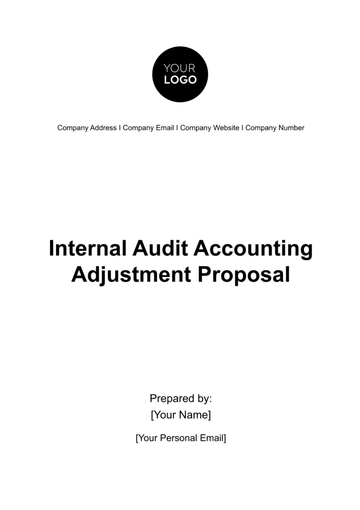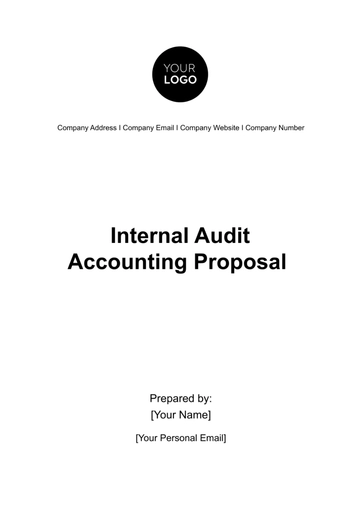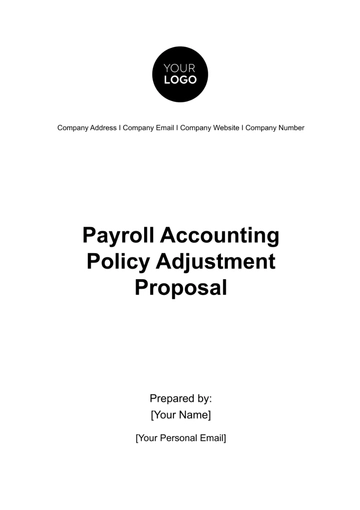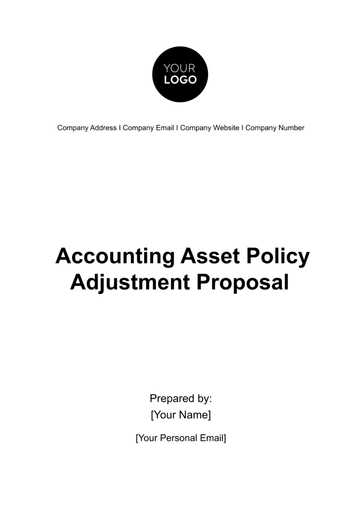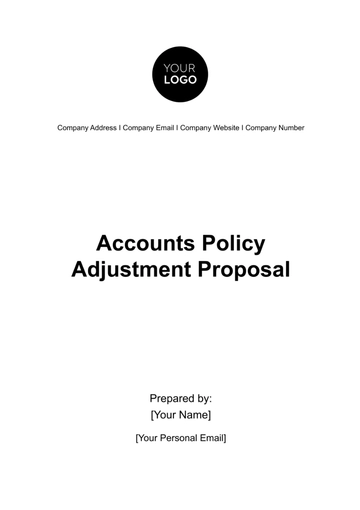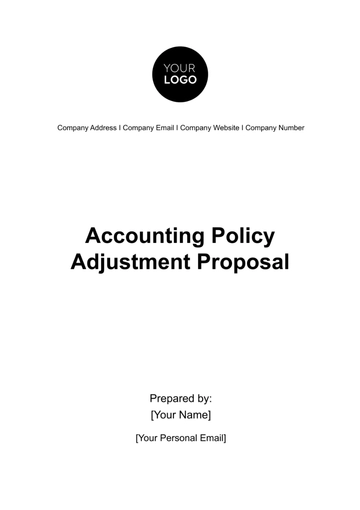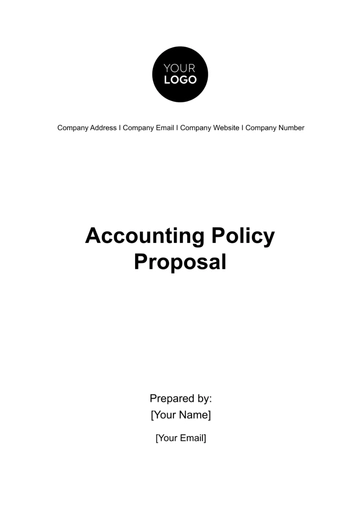Free Accounts Policy Adjustment Proposal
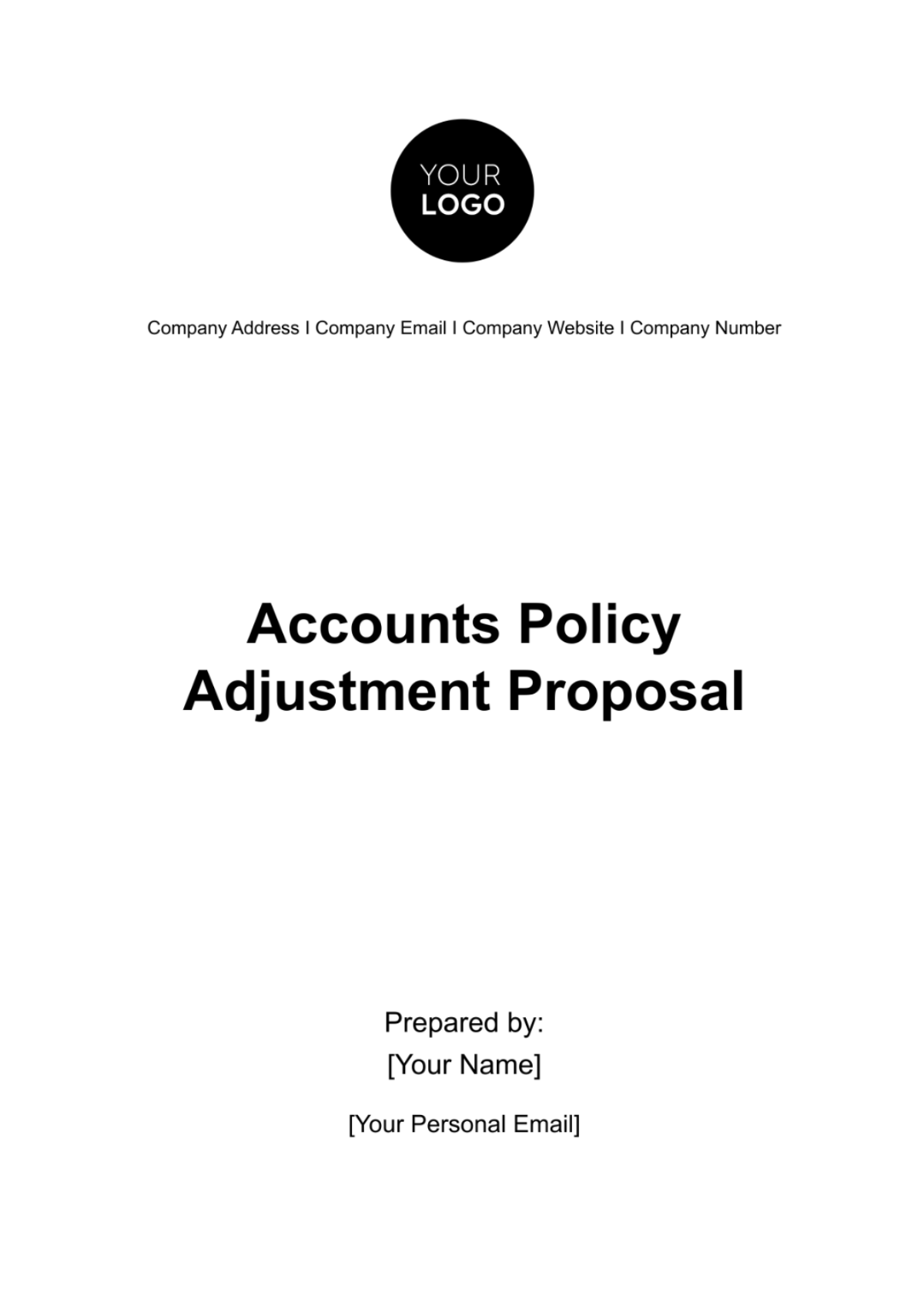
I. Executive Summary
A. Brief Overview:
This proposal outlines critical adjustments to our existing Accounts Policy, which has been instrumental in governing user account management within our organization since its inception in 2050. As part of our commitment to continuous improvement, this proposal addresses identified areas of concern, with a focus on enhancing security, user experience, and aligning with current industry standards.
B. Purpose of the Proposal:
The primary goal of this proposal is to ensure that our Accounts Policy remains robust, adaptive, and aligned with the evolving needs of our organization and industry. By addressing weaknesses, incorporating stakeholder feedback, and staying ahead of regulatory changes, we aim to fortify our account management framework, fostering a secure and user-friendly environment.
C. Summary of Proposed Adjustments:
The proposed adjustments span account creation, access control, data privacy, and technology integration. Through these changes, we anticipate strengthening our security posture, streamlining processes for both users and administrators, and proactively addressing emerging challenges in the digital landscape.
D. Key Benefits and Objectives:
The key benefits include heightened security measures, improved user experience, and enhanced compliance with data protection regulations. This proposal seeks to achieve these objectives by implementing best practices, leveraging advanced technologies, and fostering a proactive approach to account management.
II. Introduction
A. Background:
Our existing Accounts Policy, established in 2050, has been instrumental in maintaining the integrity of our user accounts. However, with the rapid evolution of technology and the changing regulatory landscape, a reassessment is essential. This reassessment aims to ensure the continued relevance and effectiveness of the policy in safeguarding our digital assets.
B. Scope of Proposal:
This proposal focuses on a comprehensive review of account creation, access control, and data privacy aspects within our organization. It excludes unrelated policies not directly influencing account management to maintain a targeted and efficient review process.
III. Policy Review and Analysis
A. Current Policy Assessment:
An in-depth examination of the existing Accounts Policy has revealed commendable strengths, such as efficient account creation and maintenance procedures, and successful access controls limiting unauthorized access. However, identified weaknesses include outdated authentication methods and a need for more robust provisions for data privacy and user consent. Recognizing these aspects is crucial for establishing a foundation upon which the proposed adjustments can address specific areas of improvement and build upon existing successful practices.
B. Industry Standards and Best Practices:
Our commitment to compliance extends to a thorough analysis of industry standards and best practices. Relevant regulations, including GDPR, CCPA, and industry-specific data protection standards, form the cornerstone of our compliance framework. Regular updates to cybersecurity regulations are closely monitored to ensure our policies align with the latest security recommendations. Benchmarking against industry competitors and adopting best practices is fundamental to maintaining a robust account management policy that not only meets regulatory requirements but also positions us as a leader in data protection and security.
C. Feedback and Stakeholder Input:
User feedback and internal stakeholder consultation play a pivotal role in shaping the proposed adjustments. User surveys have provided valuable insights into concerns regarding password complexity and account recovery options. Direct feedback channels have facilitated a deeper understanding of user expectations and pain points. Internally, collaboration with IT, Security, Legal, and Customer Service teams has ensured a holistic view, incorporating diverse perspectives. This collaborative approach to feedback collection ensures that the proposed adjustments are well-informed, user-centric, and aligned with the organization's broader goals.
IV. Proposed Adjustments
A. General Principles:
The proposed adjustments are guided by a set of overarching principles aimed at ensuring the alignment of our Accounts Policy with organizational goals. This includes a commitment to enhancing security measures, mitigating risks, and elevating user experience. Striking a balance between these principles ensures that the adjustments not only address specific pain points identified in the policy review but also contribute to the overall resilience, efficiency, and user satisfaction within our account management framework.
B. Specific Adjustments:
The proposed adjustments encompass a multifaceted approach to account management. Introducing multi-factor authentication (MFA) for all user accounts is a fundamental security enhancement, offering a layered defense against unauthorized access. Password complexity requirements will be adjusted to strike a balance between security and user convenience, addressing concerns raised in user feedback. Role-based access controls and a comprehensive review of access levels for various roles ensure granular control over permissions, enhancing overall access management. The adjustments also include streamlining account deactivation processes and providing clearer communication about account status changes, contributing to a more transparent and efficient account lifecycle management.
C. Rationale for Each Adjustment:
Each adjustment is rooted in a clear rationale aimed at addressing specific weaknesses identified in the current policy and meeting overarching organizational objectives. The introduction of MFA is justified by its proven efficacy in preventing unauthorized access and enhancing overall security. Streamlining account deactivation processes is motivated by the need to reduce security risks associated with inactive accounts and enhance overall data protection. Providing clearer communication about account status changes aligns with principles of transparency and user empowerment. Collectively, these rationales provide a solid foundation for the proposed adjustments, ensuring that they are purpose-driven and aligned with organizational goals.
V. Implementation Plan
A. Phased Rollout:
A strategic phased rollout has been designed to ensure a systematic and effective implementation of the proposed adjustments. Phase 1, scheduled for Q2 2050, focuses on the implementation of MFA, including pilot testing and user feedback collection. Phase 2, set for Q3 2050, shifts the focus to user interface improvements, accompanied by extensive user training and onboarding sessions. This phased approach allows for a controlled and iterative implementation, minimizing disruption while maximizing user understanding and adaptation to the new account management framework.
B. Communication Strategy:
Internal communication is paramount to the success of the implementation plan. Regular updates through internal newsletters and town hall meetings will foster transparency and keep employees informed about the upcoming changes. Training sessions for employees on new account management processes will be conducted through webinars and workshops, ensuring a comprehensive understanding of the adjustments. External communication, if applicable, involves proactive notifications to customers about the upcoming changes, supported by user guides and FAQs published on the website. This multi-faceted communication strategy ensures that all stakeholders are well-informed and prepared for the transition.
C. Training and Awareness:
Comprehensive training programs are central to ensuring a smooth transition to the adjusted account management framework. Workshops on MFA implementation will include interactive sessions to address queries and concerns, fostering a culture of knowledge-sharing and collaboration. Resources for employees to stay informed about policy changes, including video tutorials and documentation, will be made available to accommodate diverse learning preferences. User awareness campaigns will be launched through online tutorials and FAQs, emphasizing the positive impact of the changes on user security and experience. This holistic approach to training and awareness ensures that all stakeholders, both internal and external, are equipped to navigate the adjusted account management landscape effectively.
VI. Resource Requirements
A. Personnel:
Dedicated personnel will play a pivotal role in the successful implementation of the proposed adjustments. A project management team, comprising seasoned professionals and subject matter experts, will oversee the phased rollout. Training programs for existing staff will be designed to ensure a comprehensive understanding of the technical and procedural changes. This approach will not only facilitate the seamless integration of the new account management framework but also empower our workforce to navigate and support users through the transition effectively.
B. Technology and Infrastructure:
System upgrades and implementations are fundamental to the success of the proposed adjustments. The budget allocation will cover the procurement of hardware tokens for the MFA implementation and licensing costs for updated account management software. Additionally, a strategic investment in a secure cloud-based infrastructure will support the scalability and efficiency of the enhanced account management framework. This holistic approach to technology and infrastructure addresses both the immediate needs of the adjustments and positions the organization for future technological advancements.
C. Budgetary Considerations:
A detailed breakdown of estimated costs reveals a comprehensive view of the financial implications of the proposed adjustments. In addition to personnel and technology expenses, a contingency fund has been established to address unforeseen challenges, ensuring financial flexibility throughout the implementation process. The return on investment (ROI) analysis underscores the organization's commitment to measuring the tangible benefits against the costs incurred, providing a basis for strategic decision-making and resource optimization.
VII. Risk Assessment
A. Identification of Potential Risks:
A meticulous analysis has identified potential technical and operational risks associated with the proposed adjustments. Technical risks, such as system downtime during implementation and user resistance to new authentication methods, are acknowledged. Operational risks, including challenges in user adaptation and potential service disruptions, have been carefully considered. This comprehensive risk assessment lays the groundwork for proactive risk mitigation strategies and contingency plans to minimize the impact of unforeseen challenges.
B. Mitigation Strategies:
Effective risk mitigation strategies have been developed to address the identified technical and operational risks. Robust backup and rollback procedures have been established to minimize system downtime, while extensive user training and support resources will be deployed to mitigate user resistance. The incremental rollout approach, coupled with a dedicated support team and communication channels, will proactively manage operational challenges, ensuring a smooth transition and minimizing disruptions to daily operations.
C. Contingency Plans:
A well-defined set of contingency plans is in place to address unexpected issues that may arise during the implementation phase. These plans include a dedicated communication strategy to promptly address unforeseen challenges and a centralized support team equipped to handle and escalate user issues efficiently. Rigorous monitoring and evaluation mechanisms will be implemented to identify emerging issues, allowing for adaptive responses and reinforcing the organization's commitment to resilience and continuous improvement.
VIII. Monitoring and Evaluation
A. Key Performance Indicators (KPIs):
Strategic key performance indicators (KPIs) have been established to assess the success of the proposed adjustments. Security metrics, including a reduction in unauthorized access attempts and an increase in successful account recovery processes, will gauge the effectiveness of security enhancements. User experience metrics, such as user satisfaction scores and a decrease in support tickets related to account management issues, will provide insights into the impact on end-users. These KPIs will serve as vital benchmarks for evaluating the adjustments' overall success.
B. Evaluation Metrics:
A multifaceted set of evaluation metrics will be employed to assess various aspects of the adjustments. Compliance metrics will focus on regular audits to ensure alignment with data protection regulations, and operational metrics will measure efficiency gains in account creation and maintenance processes. An ongoing assessment of the adjustments' impact on operational workflows will guide adaptive implementation strategies. This comprehensive approach to evaluation ensures that the organization remains agile in responding to evolving needs and challenges.
C. Continuous Improvement Mechanisms:
A robust system of continuous improvement has been instituted to reinforce the organization's commitment to adaptability and responsiveness. Continuous feedback loops, facilitated through regular user surveys and stakeholder feedback sessions, will provide valuable insights for refinement. Adaptive implementation strategies, coupled with a commitment to addressing emerging issues proactively, will ensure that the organization remains at the forefront of best practices. This dynamic approach to continuous improvement reflects a culture of learning and growth within the organization.
IX. Legal and Compliance Considerations
A. Legal Review:
A comprehensive legal review has been undertaken to ensure the proposed adjustments align with existing data protection and privacy laws. Collaboration with legal counsel has been integral to addressing potential legal implications, providing a strong foundation for compliance. Anticipation of future legal developments is an ongoing process, with regular updates and active participation in industry forums to stay abreast of emerging legal trends. This proactive legal stance underscores the organization's commitment to upholding ethical standards and legal compliance.
B. Privacy and Data Protection Compliance:
The organization's commitment to robust data handling practices is highlighted through the review and update of processes to align with the latest privacy standards. Implementation of encryption and anonymization techniques adds an additional layer of protection to sensitive data. Revised consent mechanisms, designed for user-friendly interaction, emphasize transparency and compliance, fostering trust between the organization and its users.
X. Approval and Authorization
A. Endorsement by Key Stakeholders:
The endorsement by key stakeholders is a critical step in the approval process. Internal stakeholders, including executive leadership and relevant department heads, have provided their approval, documented through a consensus on proposed adjustments. External stakeholder notification, where applicable, involves proactive communication with external partners or clients impacted by the adjustments. Collaboration with external regulatory bodies ensures validation of compliance and approval.
B. Approval Process and Signatories:
An internal approval process has been meticulously defined, involving multiple layers of review to ensure a comprehensive evaluation. Documentation of approvals from key decision-makers, coupled with an external approval process for regulatory compliance, reinforces the legitimacy of the adjustments. Collaboration with legal counsel throughout the approval process ensures alignment with legal and regulatory requirements, fostering confidence in the organization's commitment to governance and oversight.
C. Governance and Oversight:
Ongoing governance and oversight are integral to the sustained success of the adjustments. The establishment of a governance committee, comprised of key stakeholders, will oversee implementation and ongoing compliance. Regular reporting and updates to executive leadership will provide transparency and accountability. This governance structure reinforces the organization's commitment to a proactive approach, ensuring that the adjustments align with strategic objectives and regulatory requirements.
- 100% Customizable, free editor
- Access 1 Million+ Templates, photo’s & graphics
- Download or share as a template
- Click and replace photos, graphics, text, backgrounds
- Resize, crop, AI write & more
- Access advanced editor
Discover unparalleled ease with the Accounts Policy Adjustment Proposal Template from Template.net. This meticulously crafted document, available in an editable format, ensures a seamless customization experience. Leverage the power of our AI Editor Tool to effortlessly tailor policies, align with industry standards, and enhance security. Elevate your account management framework with this user-friendly, customizable solution.
You may also like
- Business Proposal
- Research Proposal
- Proposal Request
- Project Proposal
- Grant Proposal
- Photography Proposal
- Job Proposal
- Budget Proposal
- Marketing Proposal
- Branding Proposal
- Advertising Proposal
- Sales Proposal
- Startup Proposal
- Event Proposal
- Creative Proposal
- Restaurant Proposal
- Blank Proposal
- One Page Proposal
- Proposal Report
- IT Proposal
- Non Profit Proposal
- Training Proposal
- Construction Proposal
- School Proposal
- Cleaning Proposal
- Contract Proposal
- HR Proposal
- Travel Agency Proposal
- Small Business Proposal
- Investment Proposal
- Bid Proposal
- Retail Business Proposal
- Sponsorship Proposal
- Academic Proposal
- Partnership Proposal
- Work Proposal
- Agency Proposal
- University Proposal
- Accounting Proposal
- Real Estate Proposal
- Hotel Proposal
- Product Proposal
- Advertising Agency Proposal
- Development Proposal
- Loan Proposal
- Website Proposal
- Nursing Home Proposal
- Financial Proposal
- Salon Proposal
- Freelancer Proposal
- Funding Proposal
- Work from Home Proposal
- Company Proposal
- Consulting Proposal
- Educational Proposal
- Construction Bid Proposal
- Interior Design Proposal
- New Product Proposal
- Sports Proposal
- Corporate Proposal
- Food Proposal
- Property Proposal
- Maintenance Proposal
- Purchase Proposal
- Rental Proposal
- Recruitment Proposal
- Social Media Proposal
- Travel Proposal
- Trip Proposal
- Software Proposal
- Conference Proposal
- Graphic Design Proposal
- Law Firm Proposal
- Medical Proposal
- Music Proposal
- Pricing Proposal
- SEO Proposal
- Strategy Proposal
- Technical Proposal
- Coaching Proposal
- Ecommerce Proposal
- Fundraising Proposal
- Landscaping Proposal
- Charity Proposal
- Contractor Proposal
- Exhibition Proposal
- Art Proposal
- Mobile Proposal
- Equipment Proposal
- Student Proposal
- Engineering Proposal
- Business Proposal




